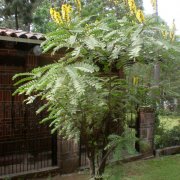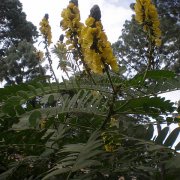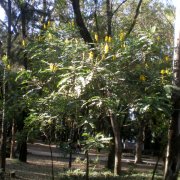Care of the shrub Senna didymobotrya or African senna |
|
The genus Senna, family Fabaceae, comprises 250 species of shrubs and trees native to temperate regions of all continents (especially South America and Australia). Many species of the genus Cassia are included in this genus. Some species are: Senna didymobotrya, Senna corymbosa, Senna artemisioides, Senna spectabilis, Senna multiglandulosa, Senna sturtii, Senna candolleana. Common names: African senna, Popcorn senna, Candelabra tree, Peanut butter cassia. This species is native to Africa. They are elegant, fast-growing shrubs with a rounded bearing that reach 3 meters (9.84 feet) in height. They have evergreen leaves (deciduous in cold weather) that give off a curious smell of roasted corn if rubbed. The attractive yellow flowers appear in erect clusters and have 5 concave petals. They can bloom 2 times: from late winter to late spring and late summer to early fall. African senna is used as isolated specimens or in small groups in the garden or in pots for terraces. Senna didymobotrya needs exposure in full sun and sheltered from the wind. It resists frosts down to -2 ºC (28.4 ºF) but the cold does not suit it because it affects the flowering. The soil must be very well drained, contain organic matter, and be deep. Water regularly but with little amount of water, waiting for the substrate to dry for a couple of days. If Popcorn senna is grown in a pot needs more watering. Fertilize in winter with manure and in spring with mineral fertilizer every 20 days. Senna didymobotrya can be attacked by aphids if the climate is very dry and by fungi if it's too humid. Peanut butter cassia is propagated by cuttings or from seeds in spring. |
Images of the shrub Senna didymobotrya or African senna |
Find plants
Senna didymobotrya or African senna | Care and Growing
© 2026 FavThemes



